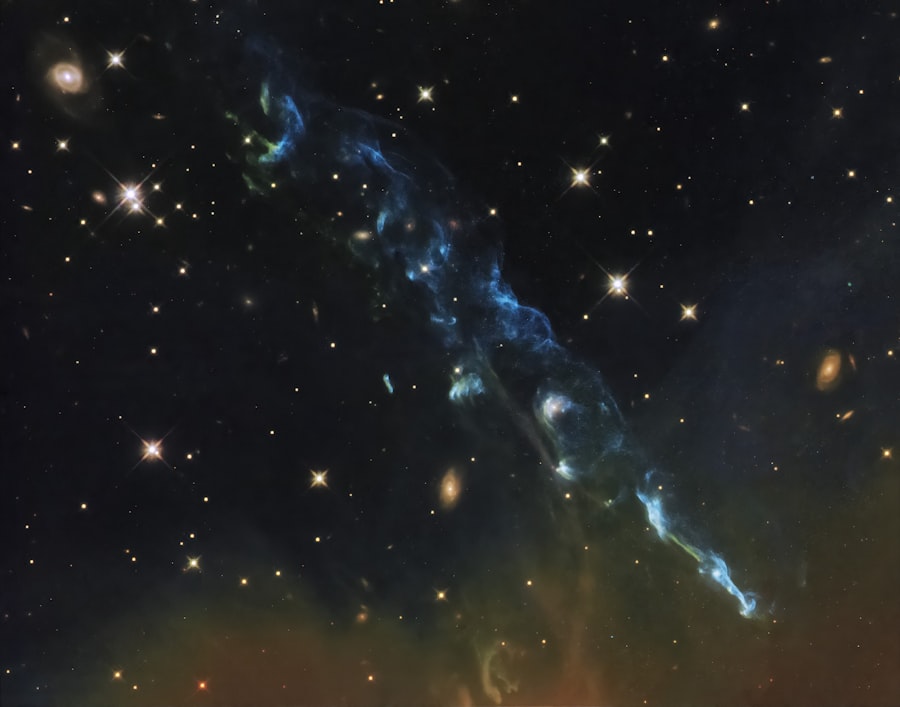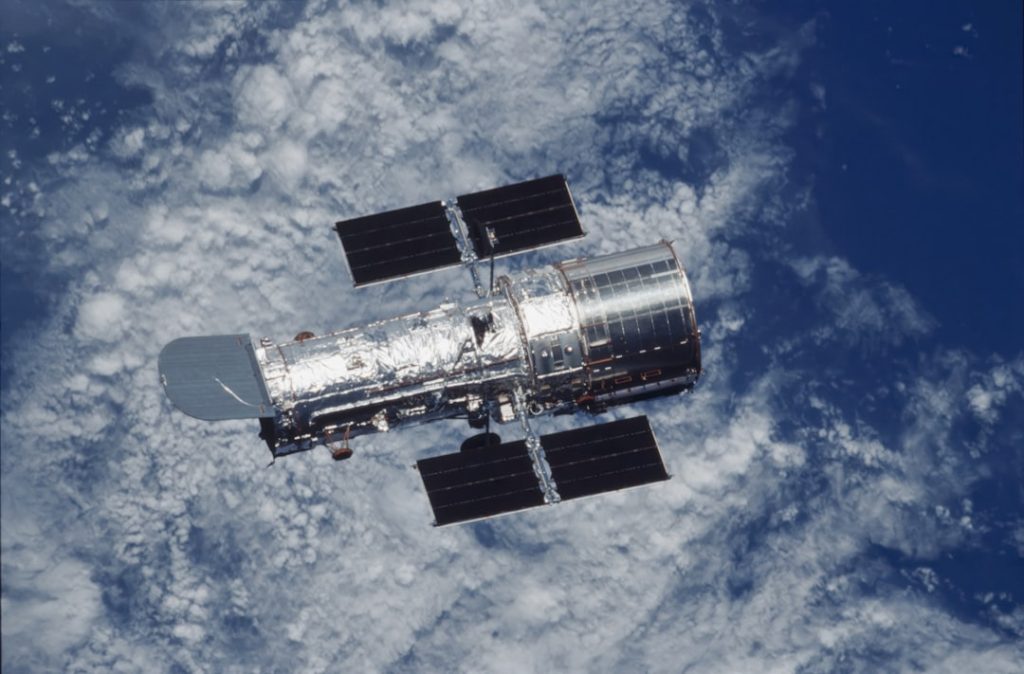The Hubble Space Telescope (HST) has a storied history that dates back to the early 20th century, when the concept of space-based observatories began to take shape. The idea gained traction in the 1940s and 1950s, as astronomers recognized the limitations of ground-based telescopes, which were hindered by atmospheric distortion and light pollution. In 1965, the U.S. National Aeronautics and Space Administration (NASA) and the European Space Agency (ESA) began collaborating on a project that would eventually lead to the development of Hubble. The telescope was named after the renowned astronomer Edwin Hubble, who made significant contributions to our understanding of the expanding universe. Construction of Hubble began in 1970, with the telescope being designed to operate in the ultraviolet, visible, and near-infrared wavelengths. After years of development and testing, Hubble was finally launched aboard the Space Shuttle Discovery on April 24, 1990. However, shortly after its deployment, it became apparent that Hubble’s primary mirror had a spherical aberration due to a manufacturing error. This flaw rendered the telescope’s images blurry and led to widespread disappointment among scientists and the public alike. Nevertheless, NASA quickly devised a plan to correct the issue, culminating in a servicing mission in December 1993 that successfully installed corrective optics, allowing Hubble to fulfill its potential.
Key Takeaways
- Hubble Space Telescope was launched in 1990 and has revolutionized our understanding of the universe.
- Hubble has made significant contributions to space exploration by capturing stunning images of distant galaxies and nebulae.
- Hubble has deepened our understanding of the universe by helping to measure the rate of expansion of the universe and discovering new planets.
- The technological advancements of Hubble, such as its ability to capture high-resolution images and its long-lasting impact, have made it a cornerstone of space exploration.
- Hubble’s 31st birthday is a celebration of its remarkable achievements and its continued impact on our understanding of the cosmos.
Hubble’s Contributions to Space Exploration
Hubble’s contributions to space exploration are vast and varied, significantly enhancing our understanding of celestial phenomena. One of its most notable achievements is its role in determining the rate of expansion of the universe. By observing distant supernovae and measuring their brightness, astronomers were able to infer how fast the universe is expanding.
This groundbreaking work led to the discovery of dark energy, a mysterious force that is driving this acceleration. The implications of this discovery have reshaped cosmology and our understanding of the universe’s fate. In addition to its contributions to cosmology, Hubble has provided invaluable insights into the formation and evolution of galaxies.
By capturing images of distant galaxies at various stages of their development, Hubble has allowed astronomers to piece together a timeline of galactic evolution. For instance, observations of the Hubble Deep Field revealed thousands of galaxies in a small patch of sky, some of which are billions of light-years away. This unprecedented view into the early universe has helped scientists understand how galaxies form and interact over cosmic time scales.
Hubble’s Impact on Our Understanding of the Universe

The impact of Hubble on our understanding of the universe cannot be overstated. Its observations have fundamentally altered our perception of cosmic structures and phenomena. One significant area where Hubble has made a mark is in the study of exoplanets.
By utilizing techniques such as transit photometry and spectroscopy, Hubble has been instrumental in detecting and characterizing planets outside our solar system. These observations have provided critical data on the atmospheres of exoplanets, revealing potential signs of habitability and expanding our search for extraterrestrial life. Moreover, Hubble has played a crucial role in refining our understanding of black holes.
Through its observations of supermassive black holes at the centers of galaxies, Hubble has helped establish a correlation between black hole mass and the properties of their host galaxies. This relationship has profound implications for our understanding of galaxy formation and evolution, suggesting that black holes may play a pivotal role in shaping their environments. The telescope’s ability to capture high-resolution images has allowed astronomers to study these enigmatic objects in unprecedented detail.
The Technological Advancements of the Hubble Space Telescope
| Technological Advancements | Description |
|---|---|
| Launch Date | April 24, 1990 |
| Primary Mirror Diameter | 2.4 meters |
| Orbit Altitude | about 547 kilometers |
| Upgrades | Five servicing missions between 1993 and 2009 |
| Advanced Camera for Surveys (ACS) | Installed in 2002, improved Hubble’s imaging capabilities |
| Wide Field Camera 3 (WFC3) | Installed in 2009, enhanced Hubble’s imaging and spectroscopic capabilities |
| Cost | Initial cost estimated at 1.5 billion |
The technological advancements embodied in the Hubble Space Telescope are remarkable and have set new standards for astronomical observation. Equipped with a 2.4-meter primary mirror, Hubble was designed to capture high-resolution images free from atmospheric interference. Its suite of scientific instruments includes cameras and spectrographs capable of observing a wide range of wavelengths, from ultraviolet to near-infrared light.
This versatility allows astronomers to study various celestial phenomena across different spectral bands. Hubble’s design also incorporates advanced stabilization technology that enables it to maintain precise pointing accuracy while observing distant objects. This capability is crucial for capturing long-exposure images without blurring caused by even slight movements.
Additionally, Hubble’s ability to be serviced by astronauts has allowed for upgrades and repairs over its operational lifetime. Five servicing missions have been conducted since its launch, each enhancing its capabilities and extending its operational life.
Celebrating Hubble’s 31st Birthday
As we celebrate Hubble’s 31st birthday, it is essential to reflect on its legacy and achievements over more than three decades in orbit. Since its launch in 1990, Hubble has transformed our understanding of the cosmos and inspired generations of scientists and enthusiasts alike. The telescope has produced over 1.5 million observations, resulting in thousands of scientific papers that have advanced various fields within astronomy and astrophysics.
The anniversary serves as a reminder not only of Hubble’s scientific contributions but also of its cultural impact. The stunning images captured by Hubble have captivated the public imagination, bringing the wonders of the universe into homes around the world. From breathtaking nebulae to distant galaxies, these images have sparked curiosity and wonder about our place in the cosmos.
As we celebrate this milestone, it is an opportunity to acknowledge the collaborative efforts between scientists, engineers, and astronauts that have made Hubble’s success possible.
Hubble’s Most Iconic Images

Hubble’s legacy is punctuated by a collection of iconic images that have become synonymous with modern astronomy. One such image is the Pillars of Creation, captured in 1995 as part of the Eagle Nebula project. This stunning photograph showcases towering columns of gas and dust where new stars are being born.
The image not only highlights Hubble’s ability to capture intricate details but also serves as a visual representation of stellar formation processes occurring in our galaxy. Another iconic image is the Hubble Deep Field (HDF), taken in 1995 when astronomers pointed Hubble at a seemingly empty patch of sky for ten consecutive days. The resulting image revealed thousands of galaxies, some dating back to just a few hundred million years after the Big Bang.
This groundbreaking observation provided profound insights into galaxy formation and evolution while demonstrating that even empty regions of space are teeming with cosmic activity.
The Future of the Hubble Space Telescope
Looking ahead, the future of the Hubble Space Telescope remains bright despite its age. While it was initially designed for a lifespan of about 15 years, ongoing servicing missions and technological upgrades have extended its operational life significantly. As it continues to function alongside newer observatories like the James Webb Space Telescope (JWST), Hubble will remain an essential tool for astronomers seeking to unravel cosmic mysteries.
Hubble’s future will likely involve continued collaboration with other observatories to provide complementary data across different wavelengths. For instance, while JWST focuses on infrared observations, Hubble excels in ultraviolet and visible light imaging. This synergy will enhance our understanding of various astronomical phenomena by allowing scientists to analyze them from multiple perspectives.
How Hubble has Inspired the Next Generation of Space Explorers
Hubble’s influence extends beyond scientific discovery; it has inspired countless individuals to pursue careers in science, technology, engineering, and mathematics (STEM). The breathtaking images produced by Hubble have ignited curiosity about space among young people worldwide, encouraging them to explore careers in astronomy and related fields. Educational programs leveraging Hubble’s findings have been developed to engage students and foster interest in space exploration.
Moreover, Hubble’s story exemplifies resilience and innovation in science. The challenges faced during its early years—particularly with the mirror flaw—demonstrate how setbacks can lead to breakthroughs through collaboration and ingenuity. This narrative resonates with aspiring scientists who learn that perseverance is often key to success in research and exploration.
In conclusion, the Hubble Space Telescope stands as a testament to human ingenuity and curiosity about the universe. Its rich history, groundbreaking contributions to space exploration, and profound impact on our understanding of cosmic phenomena continue to inspire future generations as they embark on their journeys into the unknown realms of space.


